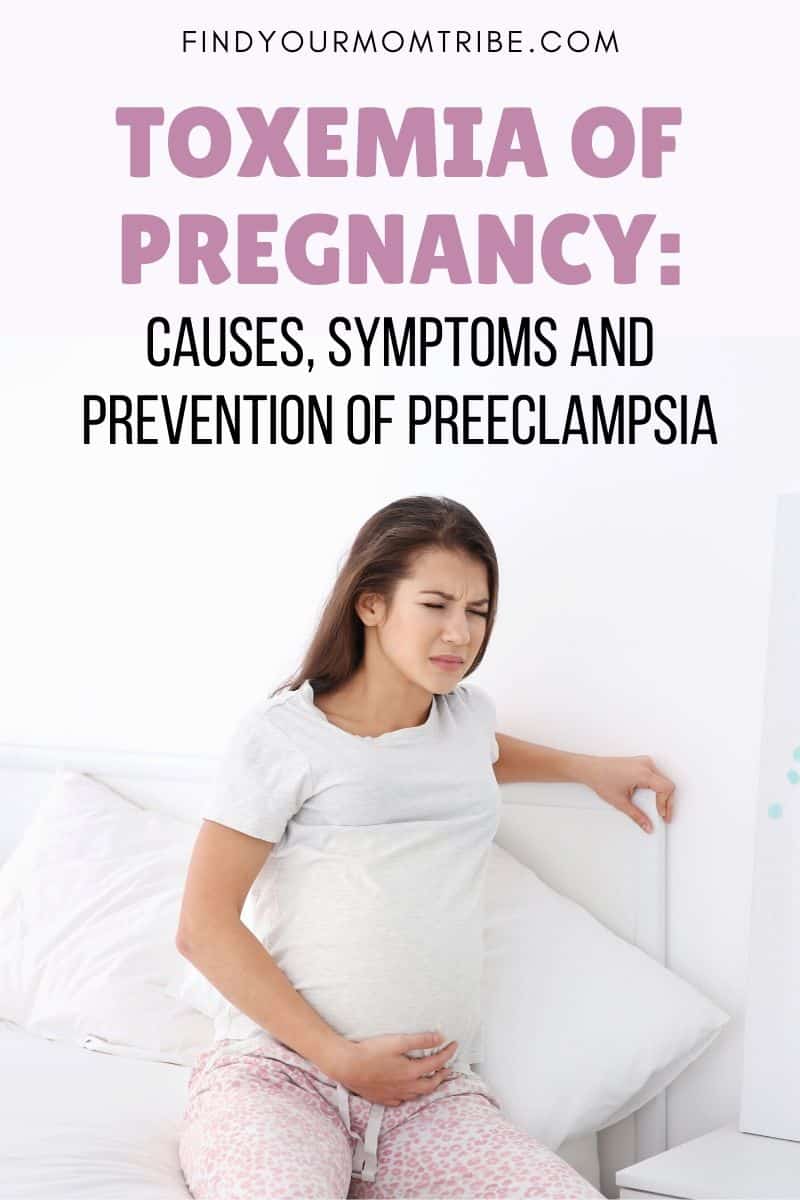Even though waiting for the arrival of your new baby is a wonderful and exciting time, there are certain medical conditions that must be kept in mind for your and your baby’s safety – and toxemia of pregnancy is one of them.
Toxemia of pregnancy or preeclampsia is a condition where an expectant mother’s high blood pressure rises and negatively affects her liver and kidneys. A woman typically has symptoms such as swelling of the extremities, weight gain, and pain in the abdominal area.
While there are many harmless bodily changes that can happen while a woman is carrying her baby, toxemia is not one of them.
In fact, it can be extremely dangerous if it isn’t diagnosed in time.
For example, toxemia of pregnancy can lead to premature birth or the baby being born with very low weight, and women with more severe conditions can even be hospitalized.
That’s why reading up on its symptoms so that you are able to timely recognize it and talk to your doctor is very important – even if you’ve had a blissful pregnancy so far!
What Is Preeclampsia Or Toxemia Of Pregnancy?

From morning sickness to a constantly changing body, pregnancy is by no means smooth sailing.
Thanks to the development of science, pregnancy and labor are no longer as dangerous and life-threatening as they were in the past.
But there are still serious medical conditions that can arise during pregnancy, one of them being toxemia of pregnancy (or as medical professionals refer to it, preeclampsia).
Characterized by high blood pressure and falling under the group of hypertensive disorders of pregnancy, it’s a relatively rare condition.
According to the March of Dimes, only 2 to 8 percent of pregnant women worldwide are diagnosed with it.
In the United States, 1 out of 25 pregnant women are diagnosed with it, according to the Centers for Disease Control and Prevention.
Apart from high blood pressure, other symptoms include protein in urine (proteinuria), and swelling of the ankles, hands, and face. Some women may even develop tinnitus during their pregnancy.
In addition, a woman might gain a large amount of weight even though she hasn’t dramatically changed her eating habits.
Then, there are also headaches, abdominal pain, and a worsening of vision or visual disturbances (such as seeing double).
Toxemia usually appears in the third trimester, around the 34th week.
As some of the above symptoms of preeclampsia (especially swelling) are just a regular pregnancy symptom, it’s important not to panic if you notice one of them.
Your health care provider is the only person who can diagnose preeclampsia and they will make sure to get a complete picture of your symptoms before making a diagnosis.
This is why it’s important to see your doctor in time and make sure to disclose anything unusual you’ve noticed lately to get an accurate diagnosis.
Apart from examining your symptoms, the doctor will run urine and blood tests to make a definite conclusion regarding your condition and they will tell you all the steps you need to take to stay as healthy as possible until your baby arrives.
What Causes Preeclampsia?

One of the more interesting ones has to do with how a woman’s immune system reacts to the fetus.
Some experts believe that the presence of the baby can cause the mother to develop a reaction, which can have a negative impact on both blood vessels and blood, in turn leading to preeclampsia.
Other theories have to do with the blood vessels that become smaller while the woman is pregnant, instead of bigger and wider, which is what should happen during a healthy pregnancy.
As the blood vessels shrink, the organs cannot receive enough blood, causing toxemia to occur.
That said, there are factors that put you more at risk of developing this condition, and your doctor will discuss them with you before making a diagnosis.
Some of these risk factors include:
- diabetes;
- gestational hypertension (blood pressure over 140/90 after two measurements conducted 6 hours apart);
- PCOS (polycystic ovary syndrome);
- older than 40 years of age;
- obesity;
- kidney disease;
- chronic hypertension;
- multiple pregnancy (carrying more than one baby);
- autoimmune diseases, such as rheumatoid arthritis;
- successful in vitro fertilization (IVF);
Other high-risk groups include women who are pregnant for the first time, teenage pregnancies, or having close family members who have been diagnosed with the same condition.
Unfortunately, if your doctor does diagnose you with preeclampsia in your current pregnancy, you have a much higher risk of developing it again if you choose to have another baby.
What Does Treatment Look Like?

But depending on the severity of your condition, there are steps to take to prevent the condition from causing complications.
First off, you will probably need to change your eating habits to decrease the amount of salt you’re ingesting while increasing your protein intake.
Monitoring your water intake is also important during this time and should include a minimum of 8 glasses of water per day.
You will also need to keep track of your blood pressure.
Your doctor can recommend bed rest as well, which can help increase the amount of blood flow to the placenta and baby, ensuring that your little one develops at a healthy rate.
A Cesarean-section can also be scheduled, but many women with preeclampsia can be induced and deliver their baby vaginally, too, so it doesn’t automatically mean that C-section is your only option.
RELATED: How Drinking Midwives Brew Can Induce Labor Naturally?
If your condition is more serious, you might be admitted to the hospital where a medical team can carefully monitor your state.
Doctors might administer corticosteroids for severe preeclampsia, which can quicken the development of your baby’s lungs in case she needs to be delivered earlier.
If your blood pressure only increases, you might also be given antihypertensive medication, which works to lower your blood pressure (such as hydralazine).
It’s important to note that you should only take medication if it has been prescribed by your doctor and never of your own accord, as it could be dangerous for both you and your baby.
Prevention Measures

No one wants to go through the added stress of a medical condition on top of preparing for a new baby!
Even though the exact causes of this condition aren’t always certain, you can minimize your risk by following some of these tips after discussing them with your doctor.
- Get enough vitamin D, either naturally through sunlight or by taking prenatal supplements that contain vitamin D, as some scientists have suggested that a deficiency in this area could lead to developing preeclampsia.
- Make sure not to miss prenatal care appointments.
- Lead a healthy lifestyle, which can also include exercising and drinking pregnancy smoothies, as it can help prevent excessive weight gain.
- Doctors may also sometimes prescribe aspirin for women who are very high-risk.
Possible Complications And Consequences

If you experience vomiting, tiredness, vision problems, pain in your chest or abdomen, nose or gum bleeding, and swollen hands or face, be sure to see a doctor right away.
Another consequence of toxemia of pregnancy is fetal growth restriction, which happens when your baby is born small and with low birth weight as a result of poor blood flow to the placenta.
It can also lead to premature delivery.
Preeclampsia increases your future chances of suffering from cardiovascular disease as well.
What’s more, if the condition is left untreated, it can develop into eclampsia, which is a more severe condition that includes eclamptic seizures.
One of the most extreme consequences of toxemia of pregnancy is placental abruption, which happens when the placenta detaches from the uterus and can cause stillbirth.
To Wrap Up
Being diagnosed with a medical condition such as toxemia of pregnancy while awaiting the birth of your child can be incredibly stressful, especially if you start reading about all the possible things that could go wrong!
And while reading up on your condition can be very beneficial for your health, remember not to fall down the rabbit’s hole of constantly googling every little symptom – it will only add to your stress levels.
In these moments, it’s best to focus on staying calm and following doctor’s orders, and remember the many women who have been through this journey and come out of it with perfectly healthy babies!
And I’m certain that you will, too.
References:
“Preeclampsia” published by the March of Dimes on the March of Dimes website in December 2017.
“High Blood Pressure During Pregnancy” published by the Centers for Disease Control and Prevention on the Centers for Disease Control and Prevention website on January 28, 2020.
READ NEXT: Symptoms, Causes And Treatment Of Shoulder Pain In Pregnancy
Like this post? Please share or pin it for later. You can also stay in the loop and follow us on Facebook, Instagram or Pinterest.

This post contains affiliate links. Please see our full disclosure for more info.

